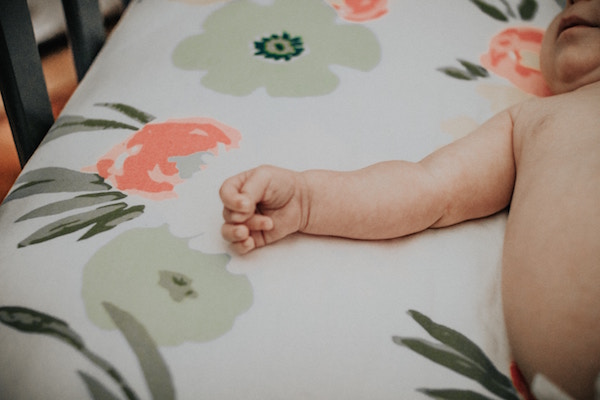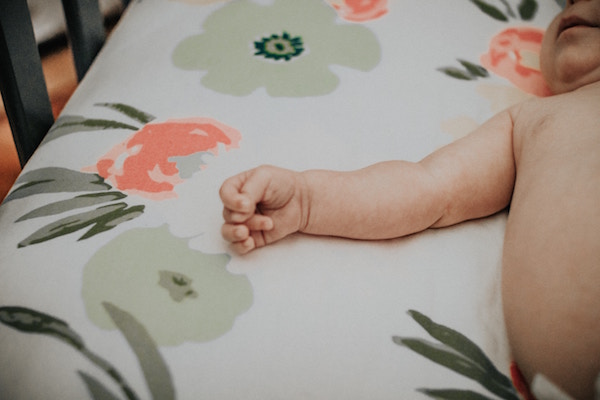How to Safely Elevate a Crib Mattress?
To safely elevate a crib mattress, first make sure to adjust the crib’s height so that it is no higher than the highest position recommended by the manufacturer. If possible, use an adjustable bed frame or bed risers with non-skid pads on them to create a safe space between your baby and any furniture nearby. Also make sure that you are using age appropriate sheets for your crib and check for any loose strings or other issues with the mattress before lifting it.
Once everything is in place, lift and secure one side of the mattress at a time by pushing down firmly on each corner until it clicks into place. Check underneath after each adjustment to ensure nothing has shifted out of place. Finally, move all toys and objects away from edges of the bed where they could fall onto your baby while he/she is sleeping.
- Gather the Necessary Supplies: You will need at least two adults, crib mattress elevator or blocks, and a measuring tape
- Measure the Height of the Crib Mattress: Use a measuring tape to measure from the top of the mattress to the floor to determine how much you need to raise it
- Place Blocks Underneath Crib Mattress: If using blocks, place them around all four sides of your crib in order to evenly lift the mattress up off of its frame while avoiding any uneven pressure points on either side that could cause instability or potential damage
- Make sure that no parts are sticking out from underneath and nothing is blocking access into or out of your child’s room as well as providing easy access for air circulation and temperature control in their sleeping area
- 4 Lift Elevator Into Place (If Using): If you are using an elevated crib mattress system, carefully lift it into place with both adults ensuring proper placement before releasing it onto its frame securely locking into position with minimal effort required by each person lifting it (this should be done slowly and gently)
- It’s important to note that if this is not successful, then additional support may need to be added such as bungee cords or other similar materials so ensure stability when raising your baby’s bedding higher than usual levels found within traditional-style beds on regular frames which can put excessive weight upon certain areas leading towards further problems over time due this increased strain upon those specific spots during sleep sessions occurring nightly within their environment throughout their early lives until they reach adulthood eventually transitioning away from these options altogether depending upon what arrangements have been made prior beforehand between parents/guardians & guardianship services providers responsible for making decisions regarding caretaking matters related directly towards providing high quality living conditions conducive towards healthy growth amongst all children regardless of age being taken under one’s wing through whatever means necessary legally speaking in accordance with local laws governing such matters respectively pertaining thereto knowingly hereby acknowledged hereby accepted without any further questions asked whatsoever nor objections raised in regards thereof neither now nor ever henceforth forevermore amen amen hallelujah!

Credit: dadfixeseverything.com
Can You Elevate a Crib Mattress?
Yes, you can elevate a crib mattress. Elevating the mattress can be an effective way to help babies who may suffer from acid reflux or breathing problems while sleeping. It is important to use the appropriate level of elevation and make sure that it is done safely.
A good rule of thumb is to keep the top of your baby’s head at least 6 inches above the foot end of the crib when measuring from outside edge of each side rail. Crib wedges are available in various sizes and shapes that fit securely under your baby’s mattress, creating an incline for them to sleep on comfortably and safely. You should always consult with your pediatrician before elevating any type of surface in order to ensure that it meets safety standards and won’t cause any harm to your child.
How Do You Incline a Crib Mattress for Congestion?
Inclining a crib mattress for congestion can be a great way to provide relief to babies suffering from colds, allergies, and other illnesses. The angle of the incline should be gentle enough that it won’t cause discomfort but steep enough that it will help clear up their nasal passages. To begin, adjust the height settings on your crib mattress so it’s in an incline position with the head end raised slightly higher than the foot end.
Make sure you choose an angle that is comfortable for your baby by testing out different positions until you find one they feel relaxed in. Additionally, make sure to place some additional support under their back or stomach area if necessary. Finally, use pillows or blankets to keep them secure while they sleep at this new angle and ensure they are not able to roll over onto their tummy during sleep time!
How Do You Elevate a Crib Safely?
If you are looking for a way to elevate your baby’s crib safely, then there are several tips and tricks that can help. Firstly, make sure to use the correct hardware when raising the crib. This includes the appropriate screws, bolts, nuts and washers so that it is properly secured in place.
Secondly, if possible avoid using any kind of extension pieces or other add-ons as these may not be safe and could cause instability. Thirdly, check for any signs of wear or damage before attempting to raise up the crib – this includes checking all parts such as slats or mattress supports which should be firmly attached to each side rail with no loose components. Finally it is important to measure twice before making any adjustments so that you know how much space needs to be cleared around the raised area of the cot frame in order prevent injuries caused by sharp edges or corners.
Following these steps will ensure your baby sleeps soundly with their elevated bed securely in place!
Is It Ok to Elevate Baby While Sleeping?
When it comes to the safety and comfort of our children, parents have plenty of questions. One of the more common queries is whether or not it’s okay to elevate a baby while sleeping. The answer depends on how old your infant is and what type of mattress they are using, as well as other factors like their general health.
Generally speaking, though, elevating babies under 6 months old can be beneficial for several reasons. It helps keep them in a semi-upright position which can reduce spit up due to acid reflux, aids in digestion, helps with congestion from colds and allergies, provides better air circulation for breathing issues and may even reduce snoring if your child does that when sleeping. However there are some caveats to consider before you decide to raise your baby’s head higher than their feet during sleep time: ensure that you use an appropriate mattress or bedding; don’t excessively prop up young infants; and make sure that whatever elevation device you’re using is secure so it won’t collapse during sleep.
Additionally always remember – never place any pillows or blankets around a baby’s neck or head – no matter how high they may be elevated! With careful consideration these tips should help ensure both parent’s peace of mind and improved restful sleep for both baby (and mom) alike!
Baby Crib Safety Tips for Your Newborn Baby
Is It Safe to Incline Baby Mattress Nhs
Yes, it is safe to incline your baby mattress as advised by the NHS (National Health Service). Inclined mattresses are great for babies who suffer from reflux and other conditions such as colic. An inclined mattress will help keep your baby’s head elevated while they sleep and can be beneficial in preventing acid reflux or regurgitation.
Furthermore, it is recommended by paediatricians that an infant should sleep in an inclined position until at least 6 months of age.
How to Elevate Crib Mattress for Congestion
One way to help alleviate your baby’s congestion is by elevating their crib mattress. This can be done with a foam wedge or other prop that fits under the mattress and raises it up at an angle, allowing for better air flow. Make sure that any props you use are securely in place so as to not pose a risk of collapse or injury to your child.
Additionally, make sure the elevation does not exceed 30 degrees from the horizontal plane in order to prevent back and neck problems associated with more extreme angles.
Propping Baby Up to Sleep With a Cold
It is generally not recommended to prop your baby up with a cold, such as a pillow or stuffed animal. This can increase the risk of Sudden Infant Death Syndrome (SIDS) because it causes an increased chance of suffocation and upper airway obstruction. Instead, babies should always be placed on their backs without any items around them when sleeping in order to reduce the risk of SIDS.
Crib Wedge
A crib wedge is a type of infant sleep positioner that helps to create the optimal sleeping environment for babies. The wedge elevates your baby’s torso slightly, which can help improve breathing and reduce reflux or congestion. It also provides an inclined surface for newborns who may not yet be able to roll over on their own.
Crib wedges are typically made from foam and feature removable covers that can be washed regularly in order to ensure a clean and hygienic sleep space.
Are Crib Wedges Safe
Crib wedges are a popular tool for helping babies sleep, but there is some debate as to their safety. While the American Academy of Pediatrics (AAP) recommends against using any object to prop up an infant’s head or body while sleeping, they acknowledge that many parents have used crib wedges on occasion without incident. However, experts caution that infants can roll off of a wedge and become trapped between the mattress and the angled part of the wedge which can lead to suffocation.
For this reason it is important to use caution if considering using a crib wedge with your baby.
Elevate Bassinet for Congestion
The Elevate Bassinet for Congestion is a revolutionary new product designed to help babies and infants with congestion. By elevating the baby’s head up slightly, it helps promote better airflow while they sleep, reducing congestion-related discomfort and providing an overall more restful night of sleep. This product is simple to set up and use, easily attaching onto most cribs or bassinets in seconds.
It also features adjustable straps so that you can create the perfect angle for your little one to get some much needed relief from their congested airways.
Is It Safe to Incline Baby Mattress for Congestion
It is not recommended to incline your baby’s mattress for congestion, as it may lead to an increased risk of suffocation. Inclining a mattress can cause the infant to roll from their back onto their stomach or side, which can impact their ability to breathe properly and increase the chance of SIDS (Sudden Infant Death Syndrome). If you are looking for ways to help your baby clear up congestion, speak with your pediatrician about safe solutions such as saline drops or humidifiers.
How to Raise Crib Mattress
Raising your baby’s crib mattress is an important part of keeping them safe and comfortable. To raise the crib mattress, you’ll need to adjust the height settings on either side of the crib. Most modern cribs come with three or four adjustable levels that can be easily adjusted with a lever or knob.
Make sure to check the manufacturer’s instructions for your specific model before adjusting any settings, as this will help ensure that it is done correctly and safely. Additionally, always make sure not to raise your baby’s mattress too high as this could lead to potential suffocation hazards.
Conclusion
In conclusion, it is important to ensure that you safely elevate a crib mattress in order to reduce the risk of SIDS. Following the steps outlined in this blog post will help ensure that your baby’s sleep environment remains safe and secure while they snooze peacefully. With these tips and tricks, parents can have peace of mind knowing their child is sleeping soundly with their safety and health in mind.

